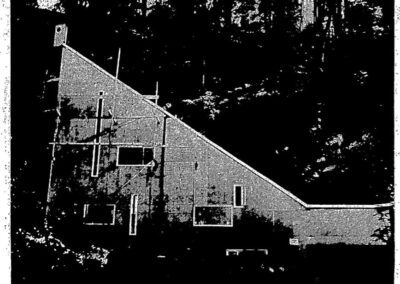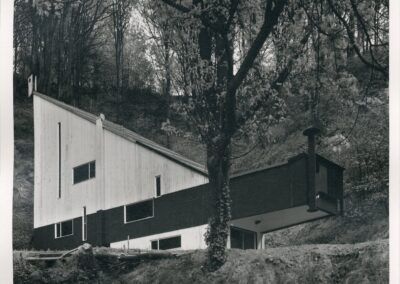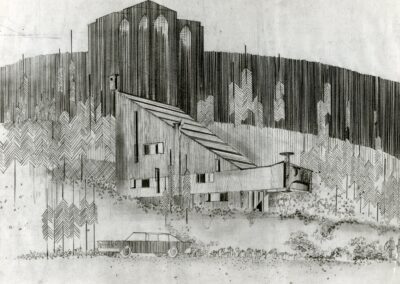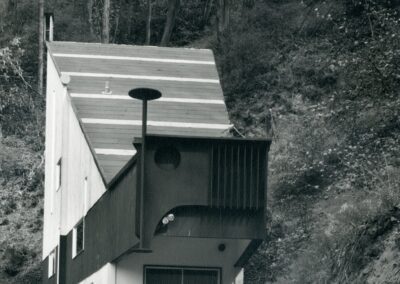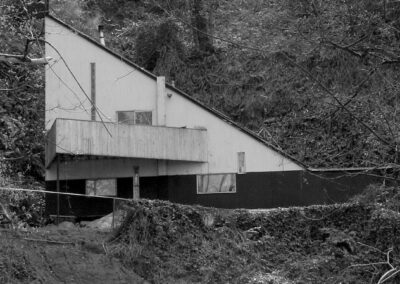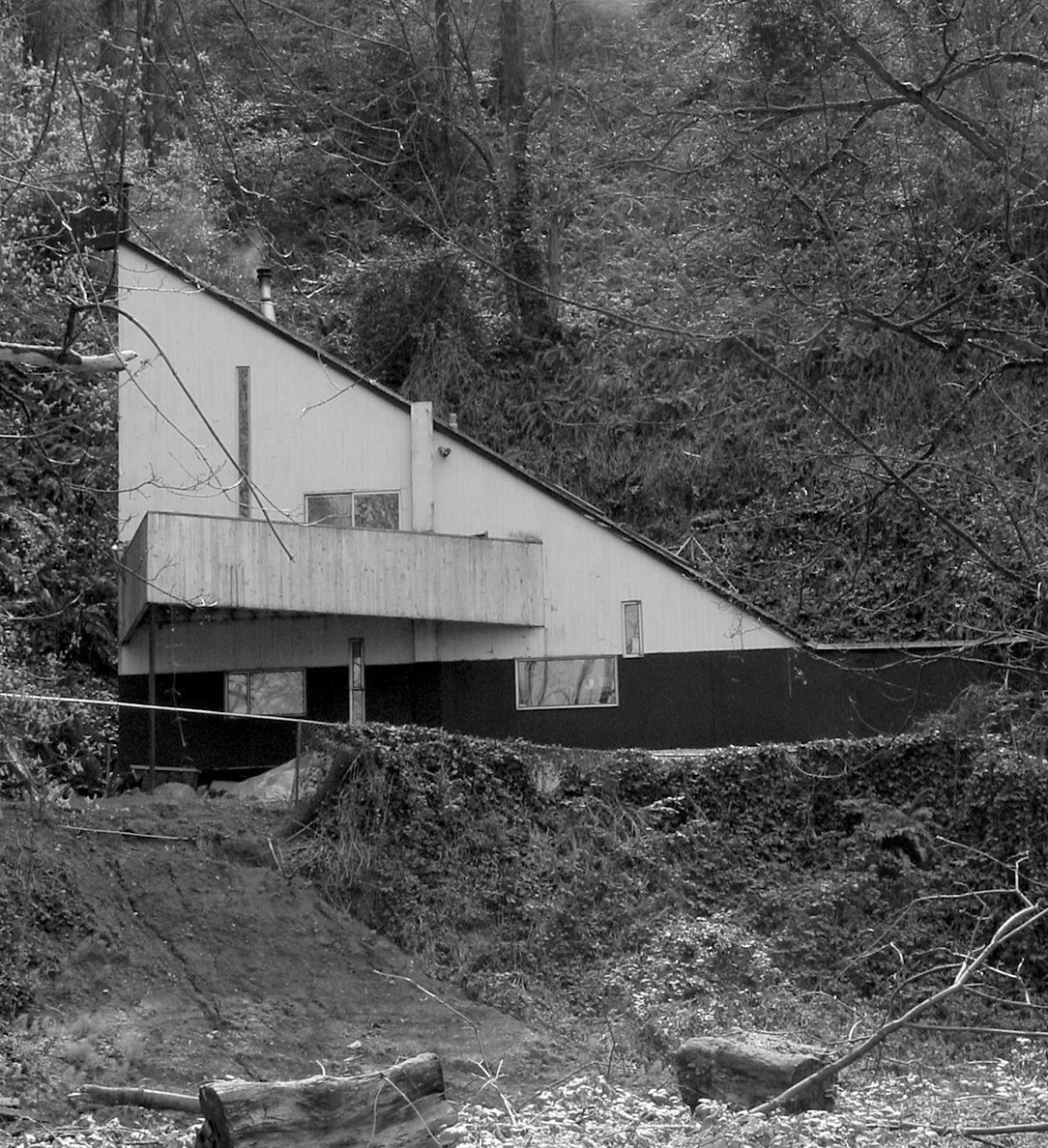
Egan House
1500 Lakeview Boulevard East, Seattle, WA 98102
Built 1958
The content below is from the 2009 Landmarks Nomination Form prepared by Docomomo WEWA.
History
The Egan House was designed by Robert Reichert in 1958 and is located at 1500 Lakeview Boulevard East in a natural bowl, at the bottom of a steeply sloping greenbelt. It is located along the western edge of the North Capitol Hill neighborhood and above the southeastern edge of the Eastlake neighborhood. The site on which the Egan House is situated is owned by the City of Seattle Parks and Recreation Department and is surrounded on three sides by parcels owned by St. Mark’s Cathedral.
The Egan House was built by Sanford Mokelbust for retired Admiral Willard Egan, U.S. Navy. Egan was actively involved in the project’s design and construction process. Egan subcontracted out the kitchen and exterior painting, but undertook the interior finishes himself.
Similar to some other older neighborhoods near the center of Seattle, Eastlake contains a broad mix of uses and building types. Traditionally, it was a blue-collar residential and industrial neighborhood.
The blocks near the Egan House retain some examples of neighborhood architectural history with Victorian farmhouses, Craftsman-style bungalows, and Mission Revival and Art Deco apartment buildings.
Modern architecture gained prominence throughout the nation after World War II, and its appeal was both ideological and aesthetic. There are several impressive, low-scale, Modern-era office buildings in the Eastlake neighborhood that provide a visual context for the Egan House design. The visual scale and character of the neighborhood, availability of relatively low-cost land, and desirable mix of uses attracted a small community of architects, engineers and related professionals who felt at ease with the existing population of artists, teachers, students, and bohemians. Eastlake was a welcoming area for the construction of design offices where designers could experiment with Modernist principles. Many of these professionals were University of Washington graduates, and became leading designers during the post-war period.
The value of Eastlake’s Modern heritage has been recognized. Several of the neighborhood’s buildings are noted in publications, such Sally Woodbridge’s Guide to Architecture in Washington State (1980), The Egan House is cited by Woodbridge as “one of Seattle’s most arresting houses.” (Woodbridge, p. 161)
Initially the Egan House was threatened by demolition as part of the City’s property acquisition. In response to community concerns, Historic Seattle Preservation and Development Authority (PDA) worked with the Seattle Department of Parks and Recreation to resolve the issue. The Historic Seattle PDA acquired the building in 1998, under a 50-year Statutory Warranty Deed (Recording No. 9802272145), which was granted by the former property owner, Gary M. Ernsdorff.
The Architect, Robert Reichert (1923-1996)
Robert George Chase Reichert was born in Fargo, North Dakota, and lived and worked in Seattle for most of his adult life. Reichert had two strong passions—architecture and music. He began studies in these fields at the age of fourteen when he was first employed by an architect and began playing the organ professionally. He attended the University of Minnesota in St. Paul, where he received an undergraduate degree in architecture in 1947.
Reportedly, Reichert’s family moved to Seattle shortly after he began college at the University of Minnesota, which may be the reason he later moved to the Northwest. During his early years at UM he also enrolled in the Mac Phial College of Music in Minneapolis. He was a member of the American Guild of Organists, and was designated as a Colleague in the organization in 1947. In 1950 Reichert attended an international meeting of organists at Westminster Abbey, Canterbury, and then traveled throughout Europe. He also studied at the Royal College of Organists in London.
He continued his architectural education at Harvard University, where he studied with the Bauhaus architect Walter Gropius and received a Master’s in Architecture in 1951. Reichert’s personal philosophy of design could not have differed more from that of his teacher when he noted that “architecture is an art, art is an attitude and therefore metaphysical and romantic . . . We must have romance in architecture and design, and this must triumph over the present-day emphasis and drama of structure, techniques and function.”
Reichert’s professional career included a private architectural practice in Seattle from 1951 to 1996, which focused primarily on residential projects. During this period he was also the organist for the Church of Christ, Seattle. He was a faculty member at the University of Washington’s Architecture Department where he taught architectural design studios.
Throughout his life, Reichert retained strong interests including church organs, motorcycles, art, and architectural design. He was open in his commitment to his Episcopal faith, noting in a local newspaper article that he “would like to think of himself not so much as an architect, teacher, or organist, but as a Christian who uses these things to express his Christianity.”
The Building and Site
The floor area of the wood-framed building is approximately 1,190 square feet. The house contains three stories within an unusual, truncated wedge-shaped form. The object-like building form has taut roof and siding surfaces and no overhangs, with the exception of the dramatic west end (originally a cantilever). Original composition roofing was applied in wide sheets resulting in the bold appearance of wide red and green stripes. Similar composition roofing was installed to maintain the striped appearance when the house was rehabilitated in 2002.
The Egan House has two highly visible facades that face north and west, although the building’s sculptural wedge-shaped form seems to defy the concept of primary and secondary facades.
Reichert’s original sketches for the house included a revealing perspective that captures the sense of the open interior space within the wedge-shaped form. It has been described as a single angular space with two upper floors inserted, like shelves, facing out toward the entry at one end. Although it is categorized as a two-story dwelling, the house appears internally as three stories.
Cast concrete basement walls enclosed 130 square feet and create a shallow entry foyer and a single service space with a toilet. To the east of this there was a small crawl space, which has been fitted with a concrete slab floor to provide additional storage. The kitchen, bathroom, and a single bedroom with closet/dressing space were arranged in a linear fashion on the first floor, above the entry level, which was accessed by an open staircase set along the north perimeter wall.
Another single flight of stairs led up to the living room on the second floor. The first and second floor levels are both held back from the west side and overlook the spaces below so that the three levels are visually connected. The open volume and plane of the ceiling corresponded to the steep shed roof shape. The dramatic flow of volumetric space is evident, particularly when viewed from the lowest level.
Original finishes and elements within the house expressed its contemporary character. These include white ceramic floor tiles, wood strip cladding on the monolithic sloped ceiling, simple flush type pocket doors, and built-in stainless steel kitchen fittings and cabinetry. The kitchen features a single cabinet unit with integral General Electric wall oven, cooktop and refrigerator/freezer—the most “contemporary” models, finished in pale turquoise enamel. The cabinet unit and appliances, which were ordered from Sears, remain within the house today, although the original cabinet refrigerator has been adapted for storage use.
The open stair featured 10” marble slabs as treads, but no risers, and a minimal support and railing system. Similarly the original upper floor level was open on its west sides, with only minimal X-bracing for railings. Original interior finishes include painted plaster and gypsum wallboard. Heating was originally provided by an in-wall ceramic coil core, replaced by electric baseboards and a non- original freestanding wood stove in the living room. Interior lighting is supplied by several simple, suspended fixtures as well as more utilitarian mounted ones.
The Egan House is similar to many post-war era architect-designed houses in that it stressed economy and material innovation, which remain among its most appealing qualities. However, the Egan House differs from many mid-century Northwest Modern houses in that it is more hermetic and tightly enclosed. The site’s steep topography and dense vegetation also contrast with typical open, suburban sites with cultivated landscaping. Instead of integration, Reichert addressed the surrounding landscape through placement and juxtaposition in an ideological rather than experiential approach to dwelling design.
Despite its conventional wood-framing, the Egan House is not characterized by rationality and repetition. It is a far more dramatic structure, with the strident geometry of its wedge-shaped massing, the two-dimensional simplicity of the triangular north facade, and the use of contrasting vertical wood siding and plywood panel cladding, which are bisected by narrow windows and openings with flush planes of glazing.
The interior is more consistent with some of the formal aspects of Modernism as exemplified by the use of contemporary materials, built-in interior cabinetry, and stairs that are detailed to read as floating, semi-transparent element. The interior also expresses the Modern tradition of flowing and open space, but diverges from the typical horizontal volumes with its compelling and dramatic angles.
